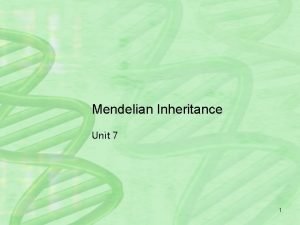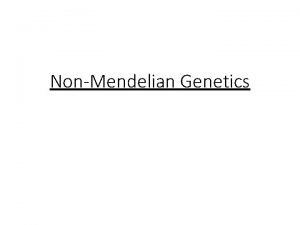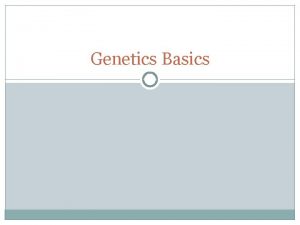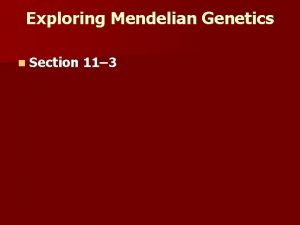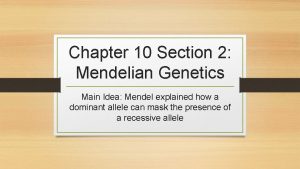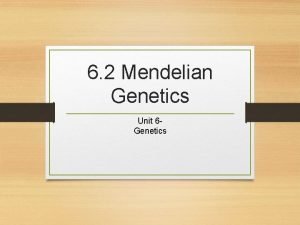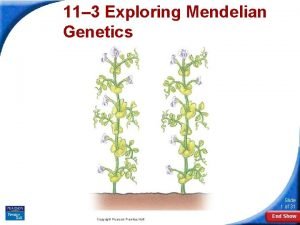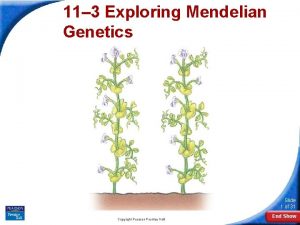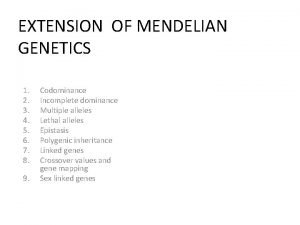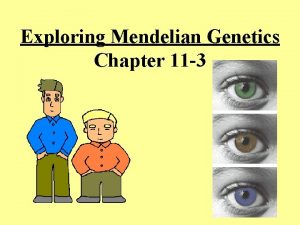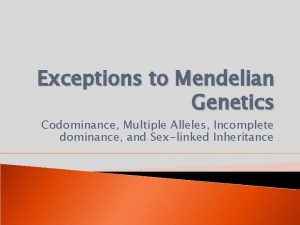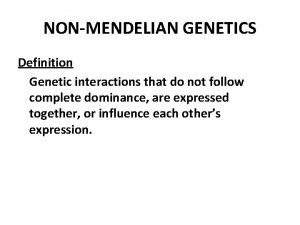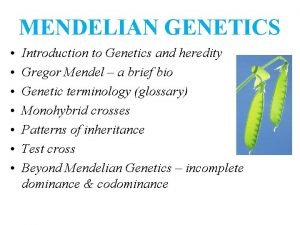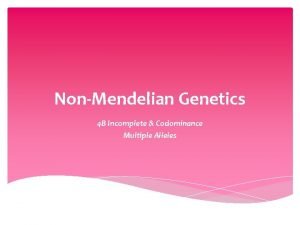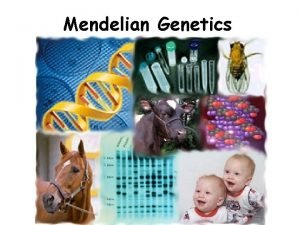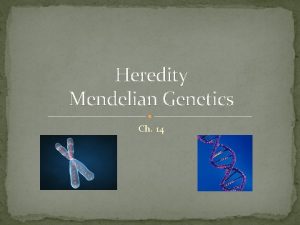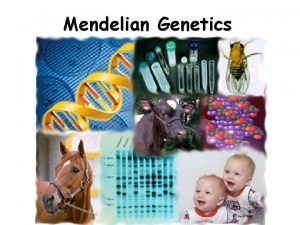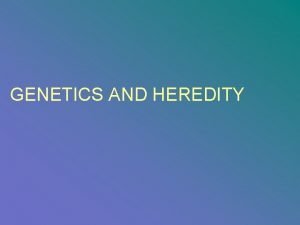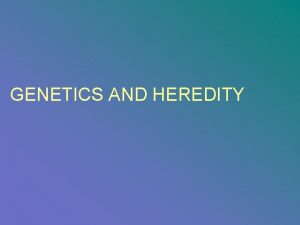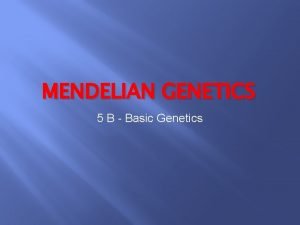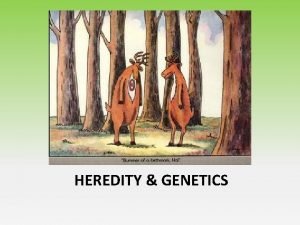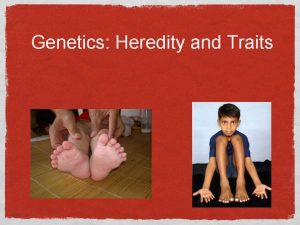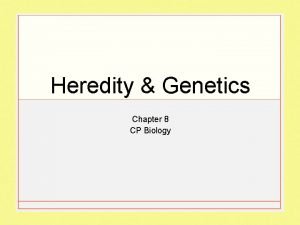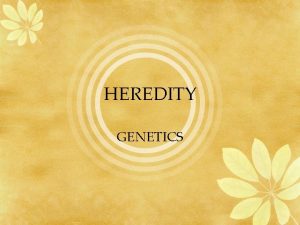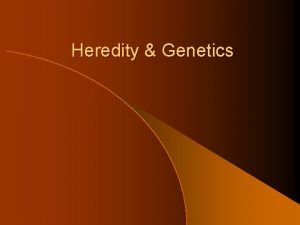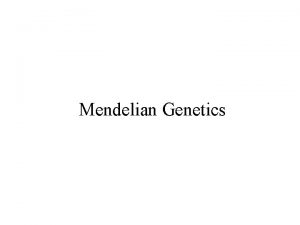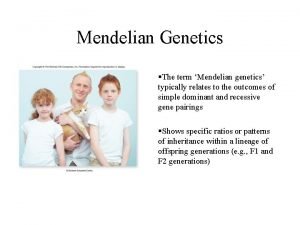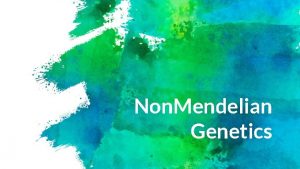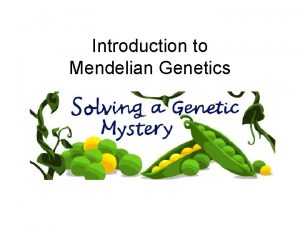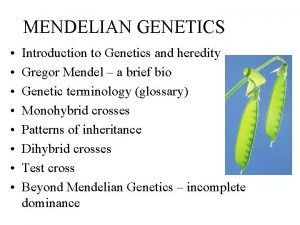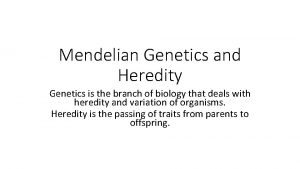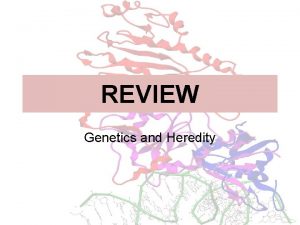Mendelian Genetics Genetics and heredity For a long
























- Slides: 24

Mendelian Genetics

Genetics and heredity For a long time, general ideas of inheritance were known + =

+ = What was really lacking was a quantitative understanding of how particular traits were passed down to their offspring.

Gregor Mendel (1822 -1884) • German monk born in 1822 • Lived in what is now the Czech Republic • Tended the garden at his monastery, conducted experiments with pea plants • Studied peas for 7 years, published results 1866; ignored until 1900 • Now considered the “Father of Genetics”

What is a trait? • A trait is a characteristic that can vary from one individual to the next (e. g. , eye color) • Mendel chose 7 pea plant traits to study: – seed shape, seed color, flower color, pod shape, pod color, flower position, plant height • He was lucky that each trait happened to be located on different chromosomes (people didn’t know about chromosomes back then)

Mendel's experiments • First, he created true (pure) breeding pea plants • Then he experimented with different traits (one at a time) – He cross-pollinated plants with different traits, and observed the offspring (Normally done by bees… Mendel used scissors and a paint brush)

Important vocabulary • True (pure) breeding = offspring always have same trait as parent (every time, no matter what!) • Self-pollination = plant fertilizes itself • Cross-pollination = one plant fertilizes another • P generation = Parent generation • F 1 generation = 1 st generation offspring (“filius” is Latin for “son”; offspring of P generation) • F 2 generation = 2 nd generation offspring (offspring of F 1 generation)

Mendel’s crosses • When Mendel crossed true-breeding tall plants with true-breeding dwarf plants (P generation)… …what size were the offspring (F 1 generation)?

• The F 1 generation were all tall

Mendel was surprised! • Mendel had expected the traits to blend: tall + dwarf = medium • Instead, the tallness of parent had masked the shortness of the other parent tall + short = tall? ?

• Mendel then let the F 1 generation self-pollinate to create the F 2 generation …what size were the offspring (F 2 generation)?

• Some of the F 2 offspring were tall, and some were dwarf • The ratio was always 3 tall to 1 dwarf (3: 1)

Mendel's findings • When Mendel crossed true-breeding plants with different traits, all of the F 1 plants showed only one trait (e. g. , all tall); the F 2 plants showed a 3: 1 ratio • He did not get “medium” plants! • He called the traits dominant (showed in F 1 generation) or recessive (didn’t show up in the F 1 generation)



Mendel’s conclusions Mendel realized that: 1. Inheritance of traits is controlled by genes contributed by each parent (e. g. , flower color)

Mendel’s conclusions 2. These genes come in different forms, called alleles (e. g. , purple or white flowers)

Mendel’s conclusions 3. Some alleles are dominant while others are recessive – When both types of alleles are present, dominant alleles mask (cover up) recessive alleles Mendel’s Discoveries & Results

Mendel’s Law of Dominance: • Generally, one allele is dominant to another • Dominant allele always expressed, even if combined with recessive allele – written as uppercase letter of the trait – e. g. , tall = dominant: TT, t. T, or Tt • Recessive allele expressed only if dominant allele is not present. – written as a lowercase letter of the dominant trait – e. g. , dwarf = recessive: tt

More vocabulary… • Genotype = genetic combination of alleles (e. g. , TT, Tt, tt) • Phenotype = physical characteristic or trait (e. g. , tall, short) • Homozygous = both alleles are the same (e. g. , TT or tt) → “true breeding” • Heterozygous = alleles are different (e. g. , Tt) • Hybrid = offspring of crosses of parents with different traits (e. g. , offspring of TT and tt)

Mendel’s Law of Segregation • When gametes form, the alleles from each parent are segregated (separated) from each other • Each gamete carries a single allele for each gene

Parents (P) gametes F 1 gametes F 2 Probability of F 2 generation being TT?

Punnett Squares • Instead of doing all of that hard work for each of the possible outcomes under the Law of Segregation, we can do a Punnett Square (geneticist Reginald Punnett created it) Father's Gametes Mother’s Gametes T t TT Tt Tt tt There is a 1 in 4 chance of the offspring being TT There is a 2 in 4 chance of the offspring being Tt There is a 1 in 4 chance of the offspring being tt 3 out of 4 plants = tall 1 out of 4 plants = dwarf Tall to dwarf = 3: 1

Mendel’s Law of Independent Assortment • Genes for two different traits are inherited independently • There is no connection between them (e. g. , plant height and seed color) Animation
 Family resemblance test
Family resemblance test Genetics is the study of heredity and variation
Genetics is the study of heredity and variation Chapter 17 lesson 2 heredity and genetics
Chapter 17 lesson 2 heredity and genetics Is baldness a sex linked trait
Is baldness a sex linked trait Section 11-4 meiosis answer key
Section 11-4 meiosis answer key Heterozygous for blood type a
Heterozygous for blood type a Extending mendelian genetics chapter 7
Extending mendelian genetics chapter 7 Section 11-3 exploring mendelian genetics
Section 11-3 exploring mendelian genetics Chapter 10 section 2 mendelian genetics
Chapter 10 section 2 mendelian genetics Mendelian genetics punnett square
Mendelian genetics punnett square 11-3 exploring mendelian genetics answers
11-3 exploring mendelian genetics answers 11.3 exploring mendelian genetics
11.3 exploring mendelian genetics Karyotype
Karyotype Pprr x pprr punnett square
Pprr x pprr punnett square Section 11-3 exploring mendelian genetics
Section 11-3 exploring mendelian genetics Multiple alleles
Multiple alleles Identify the disorder
Identify the disorder Incomplete dominance meaning
Incomplete dominance meaning Codominace
Codominace Mendel experiments in plant hybridization
Mendel experiments in plant hybridization Chapter 10 sexual reproduction and genetics
Chapter 10 sexual reproduction and genetics Mendelian inheritance pattern
Mendelian inheritance pattern Mendelian genetics vocab
Mendelian genetics vocab What does incomplete dominance mean
What does incomplete dominance mean How to do a punnett square for color blindness
How to do a punnett square for color blindness
